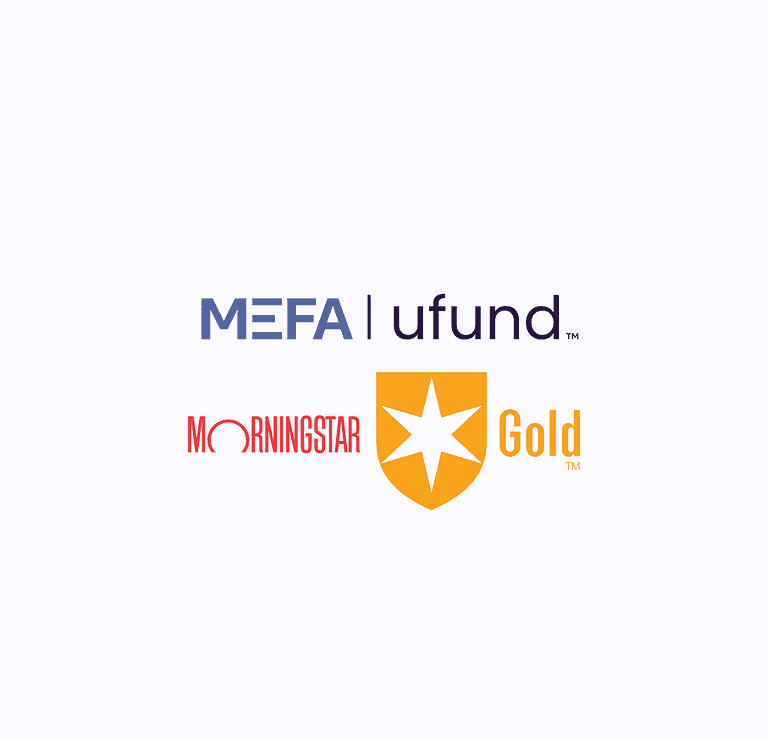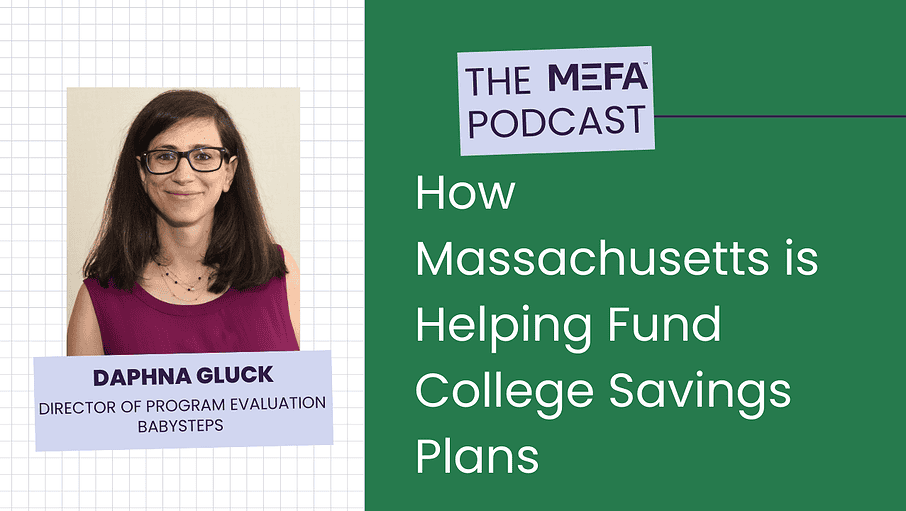

Resources Mentioned in this Episode
Jonathan Hughes: [00:00:00] Hi everyone, and welcome to the MEFA Podcast. My name is Jonathan Hughes.
Julie Shields-Rutyna: And I’m Julie Shields-Rutyna.
Jonathan Hughes: And we are recording this in September, which is College Savings Month. Of course, I don’t need to tell you that September is College Savings Month. And what this means for us today is that we’re going to be talking about college savings.
And specifically… 529 plans. So we’re going to be talking about the Baby Steps program, which is the Massachusetts first statewide seeded college savings program, basically putting $50 aside for every child born or adopted in Massachusetts into a UFund account. And that program has been around since 2020.
So later on, we’re going to be talking to the director of evaluation for that program, our friend, Daphna [00:01:00] Gluck. So she’s going to tell us how we’ve been doing since that program started, and also tell us about the first expansion of that 50 seed, which is for SNAP recipients. And that’s also kicking off in September. So we’re going to talk about that. Julie, what else should we cover today?
Julie Shields-Rutyna: Well, since we’re talking about 529 plans, I guess let’s share a little additional news about 529 plans. And as the trend has been going, there’s, it’s good news. So there have been some recent changes to 529s over the years, and the trend is always toward expansion of benefits.
So making the tax benefits of 529s for qualified withdrawals permanent. Was 1 increasing the qualified expenses to include things like K through 12 tuition and apprenticeship training is another [00:02:00] example. And those are at the federal level changes. And then, depending on the state, you live in. Families may be able to deduct contributions to a 529 on their state income taxes, as is the case in Massachusetts.
And actually most states have some tax benefit like that. And the new, newest one is in the new SECURE Act, which passed Congress at the end of 2022. And this allows up to $35,000 of a 529 plan to be rolled over to a Roth IRA without tax penalties.
Jonathan Hughes: What is a Roth IRA?
Julie Shields-Rutyna: Sure. Yes, it’s a retirement account. But it’s a specific one where you deposit after tax funds at the beginning and then you don’t pay taxes when you take distributions.
Jonathan Hughes: Okay, thank you. I didn’t know that. I know people talk about Roth IRAs. I always felt sort of foolish for not knowing what they were. So, thank you. Now I know what a Roth [00:03:00] IRA is.
So you can roll some money from a 529 into a Roth IRA.
Julie Shields-Rutyna: Exactly. And I guess all I’ll say at this point is that’s great. And that’s good news because it’s, it’s always nice for families to, to think that they have a lot of options. You know, if they use all the money, they don’t, but there are some wrinkles. So there are some stipulations with when you can do that and all of that. So I would just ask people to know that information, but stay tuned to see how this all, this all works out.
Jonathan Hughes: As Betsy Mayotte would say, I’m going to ask people to put their patience pants. I love that. Okay, so what else with 529 plans? Anything else?
Julie Shields-Rutyna: Well, yes, actually. So, this is a change that will have an impact on, on families. And it’s not a change to the 529s themselves, but a change in how they’re treated for financial aid purposes. So, As we’ve been talking about a lot on [00:04:00] this show, the FAFSA, the Free Application for Federal Student Aid, is being simplified, and there are a lot of changes happening.
And one of the big changes has to do with how 529 plans that are held by grandparents, aunts, uncles, family, friends, anyone other than the parent, how those are counted in the financial aid process. So as we know, the FAFSA asks about parent income and parent assets, student income and student assets. And so if a parent owns a 529 account for a student, the account is considered a parent asset.
And that means that just a small part of it will count in determining what the family can pay for college. And when I say small part, it’s. The figure is no more than 5. 6 percent of it. So that’s, that’s a good thing.
Jonathan Hughes: And then that hasn’t changed with the new FAFSA, right? That’s still the same.
Julie Shields-Rutyna: Exactly. [00:05:00] Exactly. So parent assets treated at that very, that very low amount of, and in fact, one of the myths that you and I spend a lot of time trying to break and talk about with, families is that parents are sometimes afraid to say it because they think, oh, that will mean I won’t get financial aid. And we do a lot of work to say that isn’t true. Savings are considered in such a small way in that process. So, so that’s the case if an account is held in a parent’s name.
Jonathan Hughes: Right. So what if it’s not held? What if a grandparent or somebody else in the parent does have it, then how does it get counted?
Julie Shields-Rutyna: Yes. So again, big change for the positive this year.
So I’ll give a a brief summary of how it was in the past. In the past we would say to someone who, say a grandparent was the account owner, you don’t have to report that on the FAFSA. But once you withdraw the funds to use them to pay for [00:06:00] educational expenses, then the amount that you withdrew was then reported on the FAFSA in the future year.
As student income and that that really affected the financial aid of the student or could have potentially affected the financial aid of the student. So that is gone. So now any 529 that’s owned by a 3rd party is not reported on the FAFSA and it doesn’t get reported. Withdrawals don’t get reported in later years or anything like that.
So, that is a nice change and I think also will help other family members, grandparents, aunts, uncles, feel, feel good about saving and not worry that it in some, some way is going to negatively affect the student.
Jonathan Hughes: Yes, I won’t get counted anywhere. If it’s owned, okay, so knowing that, right, knowing that that is a question that people [00:07:00] have when they’re setting up their 529s, I can see everyone now wanting to rush and change their 529 ownership if they’re a parent that has their account for their child, or if anybody who is setting up a new 529, they want to set it up in the name of a grandparent or somebody else, so it doesn’t get counted as an asset.
What is our guidance there for people who either already have it set up for their child in their own name as, as parents or for people who are setting it up.
Julie Shields-Rutyna: Yeah. You know, it’s really a question of ownership. So if a parent owns a 529 plan, they have full control over that and they can use it for one student.
They can transfer it to another sibling. They can use that however they want versus if a grandparent. Has a 529 account. They can use it however they want. So they can have it set up for one grandchild, but if they want to take that money out and transfer it to another [00:08:00] grandchild, they can do that as well.
So whoever is the owner has the control. And so I, you know, it’s really up to the family who they want to open the 529 plan. But I will say, going back to the beginning, even 529 plans held in the parent’s name are treated in such a small way in the financial aid process that I think it’s less about that and more about ownership.
And I guess I’ll also say: The parent can have a 529 for the child and the grandparent can as well. So families just have to think about what, what makes the most sense for them. And another little plug for it’s always a great idea for parents and grandparents to be sitting down and talking about this too.
Jonathan Hughes: That’s a great idea. Yes. So thanks so much, Julie. Now it’s time for the MEFA Mailbag. These are questions that have come into us over the past weeks and been answered by our college planning team. So remember, if you have any questions, you can email us at [email protected]. [00:09:00] You can call us at 800-449-MEFA and you can also reach us over social media on Facebook, that’s @MEFAMA, on X at @MEFATweets, on Instagram at @MEFA_MA.
Our question today comes to us from Kezia, who writes, Hi, my son is a high school senior in Massachusetts and I’m a big fan of your podcast. Thank you very much. I’m learning so much. Thank you so much for providing the Expected Family Contribution Calculator on your website. I’m self employed and I have a question. You ready, Julie?
Julie Shields-Rutyna: I’m ready.
Jonathan Hughes: Regarding the income tax paid box, line 25d is blank on my 1040. Already, we’re way above my level here. But I definitely paid estimated taxes through 2022, and I also wrote a big check to the IRS in the spring of 2023 for income taxes. owed for 2022. For the EFC, [00:10:00] would I add up my estimated taxes and income tax owed?
A lot to get to here, Julie. As I said, this is way above my head, so have at it.
Julie Shields-Rutyna: Great. Well, and the first thing I just have to say is that I’m so glad that she is using our calculator. This is a great calculator. It actually now will be called the student aid index calculator, SAI calculator instead of EFC calculator because of the new FAFSA.
And it’s just a great way for people to go in and put in information to get an idea about the type, what will be expected of them to pay for college and the type of financial aid they might be. might be available to them or to their students. So thank you for saying what you said and for using the calculator.
That’s wonderful. So the answer is yes, she is correct. That’s, she would, she would add those two [00:11:00] together to find out what, what. The IRS is, excuse me, what the FAFSA and in turn this calculator are trying to get at are how much tax a family actually paid in that, in that tax income year. So in this case, 2022, so they want to know the income and then the full tax paid.
And so that means, you know, anything that. was paid estimate, anything that was owed at the end that they had to pay. Now, if they had received a refund, then that would have been subtracted from that. So they’re trying to get the actual amount the family needed to pay for 2022. And so in her case, she would add up her estimated taxes and her income tax owed.
Jonathan Hughes: All right. Well, thank you very much, Julie. One more time, if you have any questions, you can email us at [email protected]. You can call us at 800-449-MEFA. Our Facebook is at @MEFAMA, on X @MEFATweets, [00:12:00] and Instagram at @MEFA_MA. Remember, we have a bench of college guidance experts waiting to answer your question.
Now let’s go to my conversation with Baby Steps Daphna Gluck. Baby Steps is the first statewide seeded children’s savings account in Massachusetts. The program was launched back in January of 2020 and developed by the Massachusetts Office of Economic Empowerment. MEFA, of course, is very excited to be an active partner in the program.
You may remember that we had Elena Van Tassel, the director of the Massachusetts Office of Economic Empowerment, on our show to talk about the program before, but that was a long time ago. So here to talk to us about the progress of the program. How we’re doing, how we reach folks, and to give us some exciting news about the program.
Well, who better to do that than Baby Steps Director of Program Evaluation herself, our friend Daphna Gluck. Hi, Daphna. Welcome to [00:13:00] the show.
Daphna Gluck: Hi, Jonathan. How are you?
Jonathan Hughes: Good, good. I’m excited to have you on.
Daphna Gluck: I’m excited to be here.
Jonathan Hughes: Can you, just in case folks aren’t familiar, can you reintroduce OEE, Office of Economic Empowerment, and give a quick overview of the Baby Steps program?
Daphna Gluck: So the Office of Economic Empowerment, or OEE, as we like to call it, is a department within the Office of State Treasurer and Receiver General for Massachusetts. And OEE is tasked with offering free and accessible financial education, promoting wage equity, and creating a bright future for children across the state.
We deliver programs to all residents of Massachusetts and at every stage of their life, regardless of their economic background, and we offer initiatives that are tailored to meet the unique financial experiences of veterans, women, high school students, and older adults. And anyone who’s interested in learning more about our programs can visit our website at mass.gov/treasury/empowerment. And for baby steps, this [00:14:00] is basically our flagship program. The goal of baby step is to tackle issues like college affordability or increasing the share of Massachusetts residents who go through post secondary education by getting families to start saving for the post secondary education as early as possible.
We launched in 2020 following two pilot programs. That ran in several gateway cities in Massachusetts. And the current program baby steps provides family with a 50 seed deposit to start saving for their child’s post secondary education. Basically every child who is born or adopted in Massachusetts is eligible to receive the seed deposit if their family or anyone else for that matter, opens a MIFA youth fund 529 account for them.
We also work to encourage families and support them in opening the account for their children through a network of community partners all through Massachusetts. And finally, the program offers families access to free financial education related to saving for post secondary education.
Jonathan Hughes: Great, thank you so much. And we’ll put a link [00:15:00] in the show notes to the Massachusetts Office of Economic Empowerment, obviously the Baby Steps as well. But we’ve had… A few years now, as we both mentioned, it launched back in January of 2020, along with the pandemic. But let’s talk about how we’re doing.
Daphna Gluck: Sure. So, and this is like data from this week since 2020. We’ve had a total of 27,838 accounts that have been opened and funded with a $50 seed in terms of the share of babies that participate in the program. If we look at babies that were born from 2020 to 2022, it’s over 13%. There’s still a few more babies in 2022 who can open account. until the end of 2023. So it’ll grow just a little bit. But yeah, 30 percent is a great number. It exceeds the early expectations for a 10 percent take up rate. And there’s also, we do see also some growth year to year. And an even better indication of the program success is just the overall growth in babies under the age [00:16:00] of one who have a U Fund 529 account open for them.
And in a recent study we’ve had done by the Institute for Economic and Racial Equity at Brandeis University, they found that 16 percent increase in the share of babies under one who have the UFIND 529 account. And this shows that the program is getting more families to start saving early for their child’s education.
Jonathan Hughes: Just to be clear we keep saying one because…
Daphna Gluck: Oh yes, I might have not mentioned that, but families have to open the account before the child turns one. So the program… Targets at birth or babies that are just born or adopted for that matter. And if we’re talking about a child who’s adopted, then the age doesn’t matter as long as it’s one year from adoption.
Jonathan Hughes: And so as far as top line. How much has the program actually given? We talk about 50 seeds. How much money have we actually seeded? And then on top of that, how much has been invested in those accounts?
Daphna Gluck: [00:17:00] So it’s $50 times 27,838 and that’s just over $1.39 million that was given to families through the Baby Steps program. And even more impressively, over 90 percent of families who opened the account made at least one deposit themselves into the account. There’s a wide range of deposits, but the overall customer deposits into these accounts exceeds 287 million. That’s a staggering amount. And if we add the interest that was earned on these funds, and it’s interest only from three years and some, some accounts are three years old, some are less. But the interest from these past three years brings the total value of the accounts to over $305 million.
Jonathan Hughes: Wow. That’s really great to hear.
Daphna Gluck: That’s quite a lot.
Jonathan Hughes: Yeah. That’s awesome. I mean, that I don’t often take the chance to look at those numbers, but those are really impressive. I’m glad that you’re here to talk about it. Yeah. Drilling down a little bit more on it as most. Are most folks continuing to make deposits in their accounts? And if so, what is. The average amount that they’re actually [00:18:00] putting in on a periodic basis.
Daphna Gluck: Yeah, so this is very interesting and we see a large variance in the way families are behaving with their accounts. So, as I mentioned, over 90 percent made at least one contribution but some of them make regular contributions. Some made only one and also the, the size of the individual contribution can vary quite significantly. So if we look at the amount, the median contribution, and I like to look at medians cause there is a high variance is 4, 250 per account.
Jonathan Hughes: That’s the total amount that they have contributed then.
Daphna Gluck: Yes. So the median total contribution per family is 4, 250. The average is much higher than that because we have not many, but a few accounts with very, very high contributions in them. But if we look at the distribution of those contributions, then 25% Of customers contributed less than 1500.
So that’s the first quartile. And at the end of the spectrum, 25 percent contributed more than 11, 000. So that’s the top end of the [00:19:00] quartile. So we do see a very, very wide variance in the contributions. And if you look at the frequency about 30 percent or about third actually of baby steps account holders have an automatic deposit set through the 529 account manager for Massachusetts, which is Fidelity Investment and it’s likely that there are more people who have this sort of automatic contribution meaning that they have a an automatic deposit Every month or every quarter, into their account and they can do it also through their Employer or through their credit cards and and we don’t know about that that.
And automatic deposits are extremely effective at building savings, even if you don’t have too much available income to put into the account. So we do see that many families have a small dollar monthly contribution that they do. And that can add up to a significant amount over 18 years, which is, you know, the trajectory for these accounts.
So over 1800 families have an automatic deposits of $50 or less per month. And you know, $50 times 12 times 18 amounts to $10,800 all altogether [00:20:00] and contributions over the 18 years. And if you add the interest, which is compounded onto that, then you see that you can accumulate not insignificant amount for your child’s education through these accounts.
Jonathan Hughes: I wonder if you could just give a word about why it’s important that some of those smaller numbers are coming or some of the, the under 50 are, are, is an important figure for folks to be contributing monthly.
Daphna Gluck: Sure. So I think. It’s, it’s really difficult when you think about your child’s education, how much it might cost. It really sort of overwhelms. And especially early on when children are young, there are a lot of expenses and families really have a hard time, you know, keeping up with all of their expenses. But the point is that when you start early, you don’t have to put huge amounts of money. to get into a significant amount of money at the end.
You know, even if you start with small scale deposits, but you make them regularly, it’s a long enough time for you to accumulate enough money for the future. And you can, you know, if [00:21:00] at a later date when your child is out of, you know, private daycare system and into public schools, you might have a bit more money to put in that may change in the future. But the important part is that you start early and also that you create this habit of putting money and saving regularly.
Jonathan Hughes: Okay, so let’s zoom out a little bit and ask questions. How we first interact with people. How do we inform people about the program?
Daphna Gluck: Yeah. So there are several ways for us to inform families. And I think it’s important to note here that we at baby steps and you at MEFA as well, our partners in this program we don’t know when a child is born and we don’t, we can’t identify the families. What we do have and the main method for us to reach families is through the parent worksheet that parents basically have to submit when their child is born.
It’s that they have to fill out with a baby’s name and all sorts of other details. And in the second page they are able to check a box that basically indicates that are interested in getting additional information about Baby Steps. And most of them will also give us their email and then they’ll be put [00:22:00] into a monthly email through MEFA to get information about signing up to Baby Steps and additional information about post secondary education. That’s really the main way. And about 46 percent of families actually do check the box.
Jonathan Hughes: About 46 of families. So about 46 percent of births, they actually check the box.
Daphna Gluck: Of course, do check the box. And that is, that has been consistent since the program launch program launched. Another way for families to hear about Baby Steps is through our community partners.
A lot of the work that we do here on Baby Steps is to recruit community based organizations and providers that, you know, focus, treat, and see families with infants to help spread the word about Baby Steps. So, for example we’re talking about family resource centers or VITA sites or state provided home visiting programs.
All of these partners go through a presentation or provided with information printed materials about baby steps in a variety of different language, and they can share those with their clients. And this method of spreading [00:23:00] information is really valuable for us because the organizations that we partner with have direct access to families, which we don’t have, as you know, and are also very much trusted within their communities.
And we do recognize that the first year after birth is really hectic for families. And we are competing for parents attention with a host of other concerns and considerations. So our aim is that a family will hear about baby steps from multiple sources, multiple times. So they might see it in the parent worksheet and then see the email, and then they might walk into their local WIC offices and see a RAC card or receive it in a packet from one of the DPH programs.
And then as the year ends, they might walk into a VITA site to get help in filing the. Their taxes, and then the volunteer will tell them about that. And the hope is that if they do sort of hear it again and again, at a certain point they’ll get, they’ll hear it enough time to seriously consider opening the account. We bring them to that point.
Jonathan Hughes: Yeah. And you know, this is where a lot of the work now comes in. I think for us that we do the work that we do together, which is getting [00:24:00] the folks who check the box to actually open the account. So can you talk about the ways in which we actually. Interact with families to try to get them to do so. And what gaps exist as far as You know, the folks who, who we have been able to reach and those that we haven’t.
Daphna Gluck: Sure. So, yeah , as we sort of talk, the first hurdle is just getting parents attention and then after getting their attention, they need to open the account. And in some cases, parents might need additional help to do that.
Some cases, It’s fairly easy. The enrollment process is not necessarily too cumbersome. It doesn’t, and you would know more than anyone, it doesn’t take too long. But there are some elements within the account opening process that can be intimidating or challenging for people, especially if people have not opened a savings or an investment account in the past, or people who Who are whose main language is not English.
So the main language of their proficient in is not English. So there might be some terms that they’re not sure about that are they are intimidated about. And what we’ve tried to do in the [00:25:00] past year is partner with community based organizations that are willing and able to walk families. Through the enrollment process, basically sit with the family and go through the process with them, you know, call Fidelity Investment Helpline if that’s necessary.
And along with them to answer questions. And these organizations will provide they’re usually the type of organizations that also provide assistance signing up to other benefits like snap or fuel assistance. Some of them provide financial coaching. So that’s sort of in line with what we’re doing with Baby Steps.
At the moment, we have eight enrollment hubs in Springfield, Greenfield, Greenfield. Worcester, Southbridge, Lawrence, East Boston, Quincy and Cambridge. And our, I think our outreach efforts are really focused right now on increasing and enhancing our enrollment hubs. We want to have one in every major city and as well as obviously the Berkshires and on the Cape.
And if there are any organizations that are listening to the podcast and have some interest in becoming an enrollment hub, I’m going to give this little push. You can reach out to us and our website also has our information to, to tell us about it.
Jonathan Hughes: Let’s [00:26:00] talk about the most recent development, which is the first additional funding element that we’ve added on. This is for SNAP benefit recipients. So when you talk about that, what is it and how do people take advantage of it? And how did it come about?
Daphna Gluck: Yes, this is the most exciting thing for me to talk about. So SNAP into Baby Steps, that’s the name of the program. It’s a one year pilot that we will launch later on in the summer.
And in this pilot, every baby who is themselves enrolled on SNAP will be eligible to receive an additional 120 from the Baby Steps program into their account, into their U Fund account. The money will be deposited in 12 monthly deposits of 10. And SNAP into Baby Steps is our first attempt, attempt to create a progressive element within Baby Steps.
And it’s in line with our overall strategy of what we call targeted universalism, meaning that the program itself is universal in every Baby born in Massachusetts is eligible to participate, but then we try to add additional component and do [00:27:00] outreach that will reach those families who will benefit most from this program.
And we hope that also through these monthly deposits will encourage families. Into the habit of engaging with their account, so hopefully they’ll sort of look and the balance on a monthly basis to see the money come in, and that sort of creates this habit, and it’s very similar to what we talked about earlier about those, the habit of saving and the monthly automatic deposits.
And we know that some of the benefits of, like, savings accounts have to do with the awareness and the engagement with the account. So to sign up, which is the important part families will have to complete a form. It’s a fairly simple form that gives us some basic information about the child and about the family.
And that information allows us to verify the child’s eligibility, meaning that they are indeed enrolled on snap and that their account is a baby steps account. And they will be able to sign up to SNAP into Baby Steps up until the child is 18 months old. So it’s a little bit confusing there. I’ll break it down.
You can open the Baby Steps account. Until the child is one [00:28:00] year old, but we wanted to give a little bit of extra time for families to sign up into the SNAP benefit so that if, for example, they opened the Baby Steps account only when the child was, you know, almost one year old, they won’t have to rush to sign up for SNAP.
So they have an extra six months to fill out the form and sign up into snap into baby steps. And everyone who signs up will get the same $120. So it doesn’t matter when you sign up. You will get the 12 monthly deposits of $10. And we really do hope that with this initiative, we can increase our take up rate in incomes where people have low to moderate income, where we have a lower take up rate for Baby Steps.
And also it’s just our way of giving more to people who need it more. And the best place to start is by getting into our website which will be mass.gov/snapintobabysteps.
Jonathan Hughes: Okay. Now we’ve talked a lot about accounts and dollars and, you know, sort of hard data. But if we can talk a little bit more about some of the [00:29:00] broader implications and some of the broader goals of the Baby Steps program.
Daphna Gluck: Sure, this is really important. So Baby Steps belongs to a larger family of programs that’s known as CSA programs. CSA stands for Children’s Savings Account and like Baby Steps, these type of programs provide children with a savings account.
It’s usually targeting. Post secondary education. And then there is some incentive for to start saving with a seed or with matching matched savings or something like that. In Massachusetts, the city of Boston operates a similar program. It’s called Boston saves, and it’s for Children in the Boston public school system.
CSA programs have been studied quite extensively and there have been found to be, they have been found to be quite effective at increasing the number of families who save for their children’s post secondary education and also the amount that is actually saved. And the studies have also found that there are interim benefits related to improved social and emotional functioning for the children, increased educational expectation [00:30:00] from the kids and the formation of what is known in the field as the college bound identity.
So the awareness of college and the thought that, well, college might be something for me, too. And in some cases, even health benefits were found related to these CSAs. Another important data point is that the analysis related to small scale savings for Children found that for low income Children who had less than $500 in college savings, they were three times more likely to enroll in college and four times more likely to Likely to complete and that’s like something that we keep saying, and it’s a really compelling piece of information.
And then among children who expect to go to college. So it’s a broad population. Those who had a savings account were six times more likely to actually attend than those who didn’t have these accounts. All of these benefits are even more prominent for obviously lower income families or low to moderate income families, which also explains our focus to reach these families and provide them with more resources.
And while enrollment rates for communities with low [00:31:00] to moderate income have been considerably lower than the overall statewide enrollment rate for Baby Steps, we do see in the data that the increase since Baby Steps launched in those communities to open the 529 account is high and it’s higher than the increase that is shown in higher income areas.
So, the numbers themselves, the overall numbers are low, but they’re moving up at a faster rate than in higher income communities.
Jonathan Hughes: Oh, that’s, that’s really encouraging. So if folks want to know more about the program or if they want to sign up for an account, where do they go?
Daphna Gluck: Yeah, so they just have to visit mass.gov/babysteps. The best name for a website. All the information about signing up is there or accessing help from a local enrollment hub. And if anyone has any questions or concerns, please email us at [email protected], and we would love to help you out.
Jonathan Hughes: Well, we’ll put that in the show notes as well. Daphna, thank you so much.
Daphna Gluck: Thank you.
Jonathan Hughes: All right, [00:32:00] everyone. That was it. I want to thank Daphna for being here and remember everyone, if you liked what you heard today and you want to know more about planning, saving, and paying for college and career readiness, well then follow the show. You can find us wherever you get your podcasts and please remember to review us because it does help us to keep doing what we’re doing here and getting the show out to people like you. Julie, thank you for joining me today.
Julie Shields-Rutyna: Oh, you’re so welcome.
Jonathan Hughes: And I want to thank Shaun Connolly our producer, and AJ Yee and Lauren Danz for their assistance in getting the show posted. Once again, my name is Jonathan Hughes and this has been the MEFA Podcast. Thank you very much.











